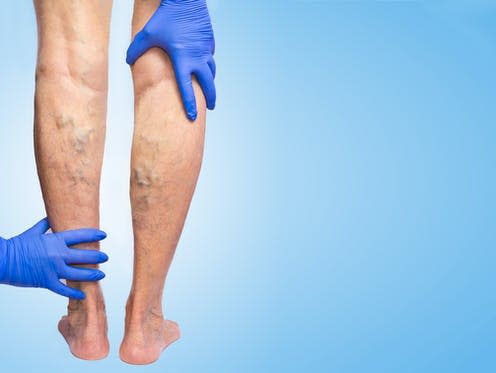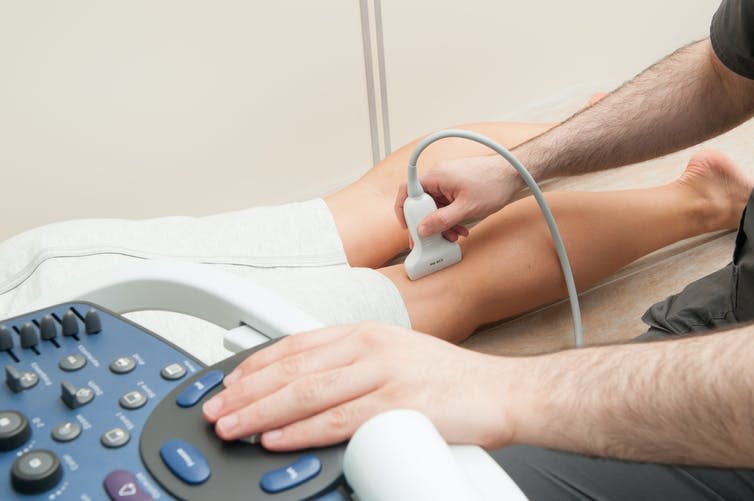Varicose veins: are they harmful?

Around 25% of women and 15% of men have varicose veins. These are swollen and twisted superficial veins – which often appear on the legs – that typically only bother people because of their appearance. But many people may not be aware that in some cases varicose veins can actually be a sign of greater health problems – as they may lead to venous leg ulcers and deep vein thrombosis, which affect our blood circulation and skin health.
Varicosities appear when vein valves and walls are damaged or weakened. This usually happens in areas that are under greater pressure, which most commonly happens in the legs – though any superficial vein may become varicosed. Research has even suggested that prolonged standing may contribute to the condition, as well as skin breakdown.
This is why certain professions, which require prolonged standing (such as nurses, butchers and hairdressers) or sitting (such as taxi-drivers, long-haul drivers), have high incidence rates. Both are related to blood pooling in the lower leg. Varicose veins are also quite common after pregnancy and increase as we age. They may also be hereditary, although there isn’t agreement on this.
Apart from looking unpleasant, for some people varicose veins can cause discomfort, itchiness, and heaviness in the lower leg (usually around the ankle) and feet, and may cramp up at night. In such cases, varicose veins may signify a deeper health issue.
This is because varicose veins aren’t just a stand-alone condition. In reality, they’re one of the earlier stages of chronic venous insufficiency (CVI), a condition that affects our lower leg venous circulation. The last stage of CVI is venous leg ulcers, which are open wounds that usually appear around the ankle. Not all varicose veins become worse - however, about 10% of people with varicose veins develop eczema and 3% of them venous ulcers.
People with varicose veins are also around five times more likely to develop deep vein thrombosis (DVT) than those who don’t have varicose veins. DVT happens when a blood clot forms in a deep vein (usually in the lower leg, thigh, or pelvis). Deep vein thrombosis can cause serious illness, disability, and in some cases, death.
Specialist diagnosis
But while varicose veins are common, it can nevertheless be difficult for someone with no clinical training to know if there’s a real danger from their varicose veins. This is because the way that the veins look doesn’t necessarily represent the true extent of the problem. For example, even a small area of “spider-like veins” could signify a bigger problem than expected. We also can’t detect just from looking at varicose veins where the problem is and if a clot is forming.
However, bleeding varicose veins, lower leg skin changes (such as eczema), swelling or persistent itching or pain, the appearance of hard veins or a lower leg ulcer usually mean that a referral to specialist is needed to determine treatment options and whether further tests are needed.

These usually start with a Duplex scan, which is a non-invasive ultrasound which will determine if and where any clots or issues are. If there is a problem, varicose veins are often treated with radiofrequency ablation (where varicose vein walls are heated using radiofrequency energy), laser therapy (where abnormal veins are heated with a laser) or sclerotherapy (where medication is infused in the vein causing it to shrink) or surgery may follow.
But people with varicose veins are sometimes overlooked or not referred for much-needed treatment. Many are also asked to self-manage their varicose veins as a first step by making lifestyle changes. These may include resting legs at a high level, exercising and avoiding sitting or standing for long periods of time. These can be part of the solution, but only the right type of tests will determine what is the correct course of action.
Lifestyle changes
It’s important to note that even after treatment, varicose veins return in approximately 20% of cases – though it’s not clear why this happens. It’s possible that apart from not having the correct treatment or a very successful surgery, there are other issues that remain unresolved with standard treatment. For example, standard surgery doesn’t remove malfunctions in the inner vein lining (called the endothelium), which is one cause of varicose veins. This may cause varicose veins to reappear.
This is why lifestyle changes can support treatment. For example, research shows that lower – but not upper – body aerobic exercise, such as treadmill walking or cycling, may help reduce recurrence of varicose veins. Losing some weight, wearing compression leg stockings and changing your diet can also reduce the pressure on the legs and improve the health of our endothelium, which might also prove beneficial in treating. Preliminary research suggests also that exercise can be beneficial for later stages of CVI (such as venous ulcers).
While most varicose veins may be harmless, if they’re causing any discomfort it’s worth speaking with your doctor to see whether they may signify a bigger health issue. Many lifestyle changes – including wearing compression stockings, eating healthy, losing excess weight, exercising, and avoiding standing or sitting for long periods without movement – may also help ensure varicose veins don’t progress to be a more serious problem.
This article is republished from The Conversation under a Creative Commons license. Read the original article.

Dr Markos Klonizakis receives funding for the FISCU II study by the National Institute for Health Research (NIHR) Research for Patient Benefit (RfPB) Programme (grant number: PB-PG-0418-20021). The views expressed are those of the author and not necessarily those of the NHS, the NIHR or the Department of Health.

 Yahoo Finance
Yahoo Finance 